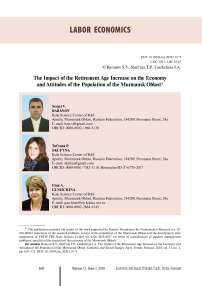The impact of the retirement age increase on the economy and attitudes of the population of the Murmansk oblast
Автор: Baranov Sergei V., Skufina Tatyana P., Gushchina Irina A.
Журнал: Economic and Social Changes: Facts, Trends, Forecast @volnc-esc-en
Рубрика: Labor economics
Статья в выпуске: 1 т.13, 2020 года.
Бесплатный доступ
The article is devoted to a meaningful analysis of the impact of the retirement age increase on the economy of the Murmansk Oblast and the attitude of its residents. The pension system, which includes protectionism for the population of the North, has a significant impact on the economy, social life, and migration of the population. Therefore, the assessment of the impact of the retirement age changes on social and economic processes is particularly relevant for the Northern and Arctic territories. Three objectives were achieved: 1. Considering the change of the retirement age, the forecast for the number of able-bodied population of the Murmansk Oblast was made. It is shown that the increase of the retirement age will halt the steady decline of able-bodied population in the region, but it will not break the trend. Comparison with the results of the forecast for Russia as a whole showed that it qualitatively distinguishes the situation in the region from the national situation. 2. The features of GRP production in the Murmansk region, based on economic and statistical modeling, are reviewed. It is established that, with the current structure of the economy, a slight reduction of the decrease rate of the able-bodied population number will not have a significant impact on the production of GRP. 3. On the basis of the survey, conducted according to a representative regional sample of the Murmansk Oblast in 2019, attitudes of the Murmansk’s population were revealed. There is a very painful perception of the retirement age increase by the population; there is a persistent opinion that change of the retirement age does not meet the interests of the population of the North and the Arctic. A negative effect of the retirement age increase was diagnosed: a change of migration attitudes among the most significant group of the Murmansk Oblast’s population (from the perspectives of regional production) - people of young (18-29 years old) and middle (30-49 years old) ages. For example, a significant number of members of these age groups have already decided to leave the Murmansk Oblast. They link their decision to the factor of the retirement age increase. Thus, the positive effect - a decrease of the rate of the able-bodied population decline in the Murmansk region, caused by the retirement age increase - will be offset by a negative effect - the growth of the rate of migration losses in the region.
Retirement age increase, arctic, murmansk oblast, grp, number of able-bodied population, modelling, survey, people's attitides
Короткий адрес: https://sciup.org/147225434
IDR: 147225434 | УДК: 338.1 | DOI: 10.15838/esc.2020.1.67.9
Текст научной статьи The impact of the retirement age increase on the economy and attitudes of the population of the Murmansk oblast
The overview of the required transformation of pension systems in developed and developing countries is the spotlight of world science. It is defined by the fact that, despite external diversity, economic and interconnected demographic processes in different countries lead to the single result – the reduction of ablebodied population (the process has different scales and speed of population ageing) [1, 2, 3, 4, 5]. Increased social vulnerability is the reality of older people. “Successful ageing” phenomenon of developed countries’ population, created by the pension system, is obscured by objective economic situation. Thus, the common point of view assumes that the population ageing will lead to further increase of capital intensity with simultaneous decrease of the capital return rate and growth of salaries [1, 2, 5, 6].
The basic problem of population ageing is solved by unpopular measures: raise of pension contributions, reduction of pension payments, and the retirement age increase [1, 2, 3, 6, 7, 8]. Summary of the research results shows that the retirement age increase is the preferred option for the economy and social sphere [9, 10]. Numerous domestic studies confirm this conclusion [4, 11, 12, 13, 14]. Thus, the authors’ studies [14] show that the steady decline of the number of able-bodied population in Russia is corrected by the retirement age increase. Studies on the specifics of Russian GDP production also confirm the thesis about the positive impact of the shift of the number of able-bodied population on economic growth [4]. It is worth mentioning many works that indicate the universality of the retirement age increase recipe for maintaining the welfare of the population and ensuring the stability of the pension system, regardless of its type and the birth rate [15, 16].
According to world studies, the retirement age increase is also based on internal demographic reserves – lengthening of a healthy life duration [17, 18]. The same trend is objectively typical for Russia: according to real data and demographic forecasts, further increase of Russians’ life expectancy is expected [19, 20]. This trend is clearly visible for residents of the Russian part of the Arctic, which is largely caused by the development of social infrastructure with the goal of bringing indicators of regional and municipal statistics of the Arctic territories closer to all-Russian ones [14, 21].
However, territorial “attachment” to the problem of population ageing has a different aspect for extremely diverse Russian regions: it is an assessment of the retirement age changes’ impact on regional processes. Numerous studies of the macroeconomic movements’ impact on the regional development show that this reaction can be very specific [22, 23, 24]. Also, a number of researchers demonstrate significant economic and social risks of regional features’ under-accounting in management practice [25, 26, 27, 28].
The pension system, which includes protectionism for the Northern territories’ population, particularly concerning the retirement age, has a significant impact on the economy, social life, and migration of the population. Therefore, the assessment of the impact of the retirement age increase on social and economic processes is particularly relevant for the Northern and Arctic territories.
Our research is based on the test of the hypothesis that the retirement age increase is a factor that can change the state of labor resources, the population’s behavior, and significantly affect the processes of the economic development in the Arctic regions.
The purpose of the work is to analyze the impact of the retirement age increase on the economy and attitudes of residents of the Arctic region – the Murmansk Oblast.
Objectives: 1) to make a long-term forecast, which takes into account the retirement age increase, for the number of able-bodied population in the Murmansk Oblast; 2) to review the features of the GRP production in the Murmansk Oblast; 3) to reveal attitudes of the Murmansk Oblast’s population, caused by the retirement age increase.
It should be noted that there are still no such assessments: this fact determines not only the fundamental novelty, manifested in the established interconnections and the development trends of the Murmansk Oblast, caused by the retirement age shift, but also the obvious scientific and practical novelty, caused by new strategic objectives of the Russian Arctic’s development.
Forecast for the number of able-bodied population in the Murmansk Oblast, which considers the retirement age changes
The Murmansk Oblast shows quite high rates of population ageing, which corresponds with the situation across Northwestern Federal District ( Tab. 1 ). The analysis of the population’s natural movement ( Tab. 2 ) and
Table 1. Age composition of the population by regions of Northwestern Federal District (year-end estimate, % of the total population)
|
Territory |
People below working age |
People of working age |
People above working age |
|||||||||||||||
|
a |
a |
a |
a |
co |
a |
a |
a |
a |
a |
co |
a |
a |
a |
a |
a |
CO |
a |
|
|
Northwestern Federal District |
15 |
15 |
16 |
16 |
17 |
17 |
61 |
60 |
59 |
58 |
57 |
57 |
24 |
25 |
25 |
26 |
26 |
27 |
|
Republic of Karelia |
17 |
17 |
17 |
18 |
18 |
18 |
59 |
58 |
57 |
56 |
55 |
55 |
24 |
25 |
25 |
26 |
27 |
27 |
|
Komi Republic |
19 |
19 |
19 |
20 |
20 |
20 |
62 |
61 |
60 |
59 |
58 |
57 |
19 |
20 |
20 |
21 |
22 |
23 |
|
Arkhangelsk Oblast |
17 |
18 |
18 |
19 |
19 |
19 |
59 |
58 |
57 |
56 |
55 |
55 |
23 |
24 |
25 |
25 |
26 |
26 |
|
including: |
||||||||||||||||||
|
Nenets Auton. Okrug |
23 |
24 |
24 |
24 |
25 |
25 |
61 |
60 |
60 |
59 |
58 |
57 |
15 |
16 |
16 |
17 |
18 |
18 |
|
Arkhangelsk Oblast without Auton. Okrug |
17 |
18 |
18 |
18 |
19 |
19 |
59 |
58 |
57 |
56 |
55 |
54 |
23 |
24 |
25 |
26 |
26 |
27 |
|
Vologda Oblast |
17 |
18 |
18 |
19 |
19 |
19 |
59 |
58 |
57 |
56 |
55 |
54 |
24 |
24 |
25 |
25 |
26 |
27 |
|
Kaliningrad Oblast |
16 |
16 |
17 |
17 |
17 |
18 |
61 |
60 |
59 |
58 |
58 |
57 |
23 |
24 |
24 |
25 |
25 |
25 |
|
Leningrad Oblast |
14 |
14 |
14 |
15 |
15 |
15 |
60 |
60 |
59 |
58 |
57 |
57 |
26 |
26 |
27 |
27 |
28 |
28 |
|
Murmansk Oblast |
17 |
17 |
18 |
18 |
18 |
19 |
64 |
63 |
62 |
61 |
60 |
59 |
20 |
20 |
21 |
21 |
22 |
22 |
|
Novgorod Oblast |
16 |
16 |
17 |
17 |
17 |
18 |
57 |
56 |
55 |
54 |
54 |
53 |
27 |
28 |
28 |
29 |
29 |
30 |
|
Pskov Oblast |
15 |
15 |
16 |
16 |
16 |
16 |
58 |
57 |
56 |
55 |
54 |
54 |
27 |
28 |
28 |
29 |
29 |
30 |
|
Saint-Petersburg |
13 |
13 |
14 |
14 |
15 |
15 |
61 |
61 |
60 |
59 |
58 |
58 |
26 |
26 |
26 |
26 |
27 |
27 |
|
For reference, Russia |
17 |
17 |
18 |
18 |
18 |
19 |
60 |
59 |
58 |
57 |
57 |
56 |
23 |
24 |
24 |
25 |
25 |
25 |
Table 2. Number of births and deaths by regions of Northwestern Federal District, per 1000 people
|
Territory |
Number of births per 1000 people |
Number of deaths per 1000 people |
||||||||||
|
2012 |
2013 |
2014 |
2015 |
2016 |
2017 |
2012 |
2013 |
2014 |
2015 |
2016 |
2017 |
|
|
Northwestern Federal District |
12.2 |
12.2 |
12.3 |
12.5 |
12.4 |
11.1 |
13.8 |
13.4 |
13.3 |
13.4 |
13.2 |
12.8 |
|
Republic of Karelia |
12.6 |
11.9 |
12.3 |
12.2 |
12.0 |
10.3 |
15.4 |
14.6 |
14.6 |
15.3 |
14.8 |
14.6 |
|
Komi Republic |
14.0 |
14.2 |
14.2 |
13.7 |
13.1 |
11.5 |
12.2 |
12.0 |
12.2 |
12.4 |
12.4 |
11.8 |
|
Arkhangelsk Oblast |
12.8 |
12.8 |
12.6 |
12.4 |
12.0 |
10.7 |
13.6 |
13.3 |
13.3 |
13.5 |
13.5 |
13.0 |
|
including: |
||||||||||||
|
Nenets Auton. Okrug |
17.3 |
16.4 |
16.8 |
17.6 |
18.5 |
15.2 |
10.2 |
10.7 |
8.9 |
9.2 |
8.9 |
8.6 |
|
Arkhangelsk Oblast without Auton. Okrug |
12.6 |
12.7 |
12.5 |
12.2 |
11.8 |
10.5 |
13.8 |
13.4 |
13.4 |
13.6 |
13.7 |
13.2 |
|
Vologda Oblast |
14.0 |
13.8 |
13.6 |
13.7 |
13.3 |
11.4 |
15.1 |
15.0 |
14.8 |
14.8 |
15.0 |
14.4 |
|
Kaliningrad Oblast |
12.4 |
12.4 |
12.6 |
12.7 |
12.4 |
11.0 |
13.2 |
13.1 |
13.3 |
13.2 |
12.5 |
12.5 |
|
Leningrad Oblast |
9.0 |
8.8 |
9.1 |
9.0 |
9.2 |
8.3 |
14.7 |
14.4 |
14.5 |
14.0 |
14.0 |
13.3 |
|
Murmansk Oblast |
11.8 |
11.9 |
11.7 |
11.9 |
11.2 |
10.3 |
11.3 |
11.0 |
11.4 |
11.6 |
11.5 |
11.1 |
|
Novgorod Oblast |
12.1 |
11.8 |
12.0 |
11.9 |
11.7 |
10.3 |
17.9 |
17.8 |
17.4 |
17.5 |
17.5 |
17.1 |
|
Pskov Oblast |
11.1 |
11.0 |
10.9 |
11.0 |
11.1 |
9.5 |
19.6 |
18.6 |
18.4 |
18.2 |
17.9 |
17.4 |
|
Saint-Petersburg |
12.6 |
12.6 |
13.0 |
13.6 |
13.8 |
12.5 |
12.4 |
11.9 |
11.7 |
11.9 |
11.7 |
11.4 |
|
For reference, Russia |
13.3 |
13.2 |
13.3 |
13.3 |
12.9 |
11.5 |
13.3 |
13.0 |
13.1 |
13.0 |
12.9 |
12.4 |
Table 3. Coefficients of migration growth (loss) by regions of Northwestern Federal District, per 1000 people
|
Territory |
2012 |
2013 |
2014 |
2015 |
2016 |
2017 |
|
Northwestern Federal District |
5.8 |
7.2 |
4.1 |
1.6 |
4.1 |
5.5 |
|
Republic of Karelia |
-1.5 |
-1.3 |
-0.7 |
-1.2 |
-1.6 |
-3.1 |
|
Komi Republic |
-12.2 |
-12.0 |
-10.7 |
-10.1 |
-8.1 |
-11.2 |
|
Arkhangelsk Oblast |
-8.5 |
-8.2 |
-6.5 |
-6.8 |
-5.6 |
-6.9 |
|
including: |
||||||
|
Nenets Auton. Okrug |
1.2 |
-0.3 |
0.1 |
2.3 |
-7.3 |
-5.3 |
|
Arkhangelsk Oblast without Auton. Okrug |
-8.8 |
-8.5 |
-6.8 |
-7.2 |
-5.6 |
-7.0 |
|
Vologda Oblast |
-0.9 |
-1.1 |
-0.7 |
-1.7 |
-1.5 |
-3.1 |
|
Kaliningrad Oblast |
9.2 |
9.4 |
6.7 |
8.2 |
10.1 |
9.9 |
|
Leningrad Oblast |
15.6 |
12.9 |
12.0 |
6.8 |
12.1 |
17.1 |
|
Murmansk Oblast |
-10.1 |
-12.9 |
-6.5 |
-5.7 |
-5.7 |
-4.6 |
|
Novgorod Oblast |
-0.4 |
0.5 |
-0.6 |
0.7 |
0.6 |
-3.1 |
|
Pskov Oblast |
0.4 |
0.1 |
-0.8 |
-0.1 |
0.3 |
-0.9 |
|
Saint-Petersburg |
14.8 |
19.7 |
10.2 |
4.9 |
8.5 |
12.1 |
|
For reference, Russia |
2.1 |
2.1 |
1.9 |
1.7 |
1.8 |
1.4 |
|
Source: Regions of Northwestern Federal District. Socio-Economic Indicators.2018: stat.coll. Komistat; Syktyvkar, 2018. 189 p. |
||||||
Figure 1. Dynamics of the number of the Murmansk Oblast’s population for 2000–2036 in absolute values, people (a) and values are compared with the level of 2000 (b):
person
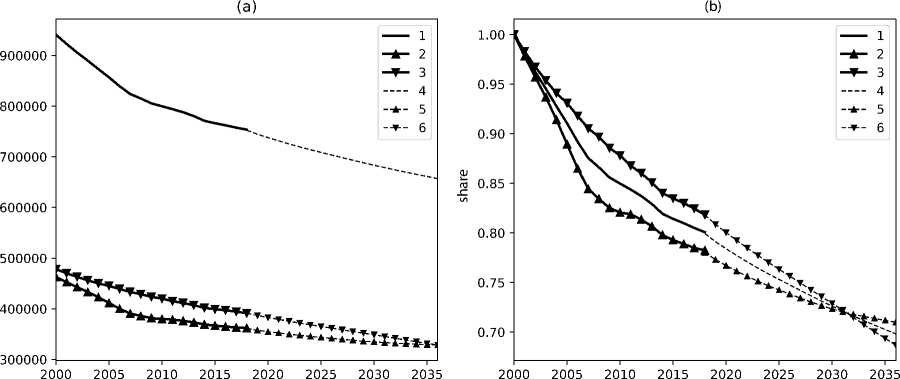
1 – actual data for the entire population in 2000–2018; 2 – actual data for men in 2000–2018; 3 – actual data for women in 2000–2018; 4 – forecast values for 2019–2036; 5 – forecast values for men in 2019–2036; 6 – forecast values for women in 2019–2036.
Source: own calculations according to data of Federal State Statistics Service.
Figure 2. Dynamics of the number of able-bodied population (people) in the Murmansk Oblast for 2000–2036:
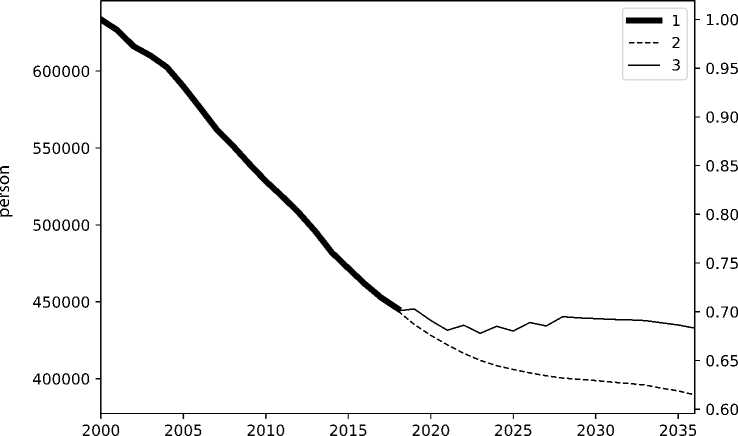
1 – actual data for 2000–2018; 2 – forecast values for 2019–2036 according to old retirement scheme; 3 – forecast values for 2019–2036 according to new retirement scheme.
Source: own calculations according to data of Federal State Statistics Service.
migration processes ( Tab. 3 ) shows that, in the Murmansk Oblast, it is caused by two factors: the population’s strong migration outflow and low birth rates.
Using the data of official demographic forecast until 2016, Rosstat data on the genderage structure of the Murmansk Oblast’s population, and the scheme of the retirement age increase, we did the long-term forecast for the number of able-bodied population of the Oblast, which took into account the increased retirement age. Figure 1 contains forecast data, acquired in 2000, in absolute and relative values.
The decline of the able-bodied population number in the Murmansk region, which has been observed since 2000, is noteworthy ( Fig. 2 ). If you keep the working age for women, aged from 16 to 50, and men, aged from 16 to 55 (for residents of the North, without pension reform), the further decline of ablebodied population, on the average level of 0.73% per year, is projected. By 2036, it will have reached 14% in comparison with 2018 (in the Murmansk Oblast, there will be 389.502
able-bodied people). With the new retirement scheme, the rate of able-bodied population decline is projected to decrease to 0.14% per year. Starting in 2027, the decline will practically stop and, by 2036, the number of able-bodied population will have decreased by 4.4% in comparison with 2018 (in the Murmansk Oblast, there will be 432.878 ablebodied people).
In our previous studies, we, taking into account the retirement age increase, made a three-variant forecast for the number of ablebodied population of the Russian Federation in 2018–2036 [12]. The forecast showed that the decline of the number of able-bodied population in the country has been observed since 2006 (the maximum value is 90157.93 thousand people). With the preservation of the working age (without pension reform), a further decline of the number of Russian able-bodied population is forecasted in all variants ( Fig. 3 ). The retirement age increase changed decline trends – the number of ablebodied population will grow: the 2006 value, according to the high variant of the forecast,
Figure 3. Dynamics of the number of able-bodied population (thousand people) for 1995–2036*:
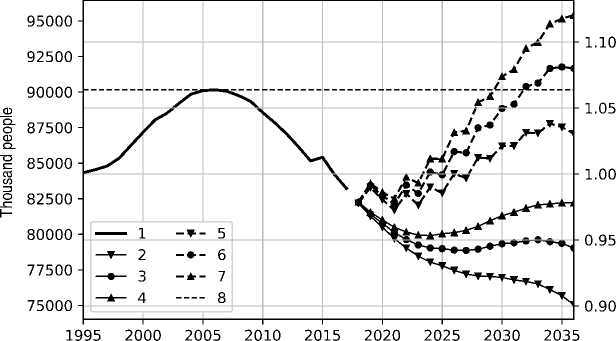
1 – actual data for 1995–2017. Forecast values for 2018–2036 according to old retirement scheme (women – 16–54 years, men – 16–59 years): low (2), average (3), high (4) forecast variant. Forecast values for 2018–2036 with new retirement scheme: low (5), average (6), high (7) forecast variants. 8 – maximum number of able-bodied population, observed in 2006.
* On the right axis, the values of the indicator are given in comparison with the level of 1995.
Source: own calculations according to data of Federal State Statistics Service [12].
will have been achieved by 2029, according to the average variant – by 2032, according to the low variant – 2006 value will not be achieved.
Thus, the dynamics of the number of ablebodied population change in the Murmansk Oblast is significantly different from the national dynamics. In the Murmansk Oblast, the retirement age increase will not be able to provide the growth of this indicator’s values.
Features of GRP production in the Murmansk Oblast
The pension reform, in terms of the retirement age increase, directly regulates the number of able-bodied population. Therefore, to identify the impact of the retirement age increase on GRP production, it is necessary to find a connection between these indicators.
Figure 4 contains the dynamics of values of accepted factors-indicators, which define the GRP production while modelling regional production processes – regression models and production functions (indices of the physical GRP volume, investments in fixed assets, and the index of able-bodied population) for 1998– 2016 in comparison with 1997 [29, 30, 31, 32] – with traditional research instruments.
The connection between GRP, investments, and the number of able-bodied population will be overviewed as a production function:
Y = AKpLq , p + q = 1, (1)
where Y – GDP; K – investments in fixed capital; L – number of able-bodied population; A = exp(a) – neutral technical progress; p – labor elasticity coefficient (number of ablebodied population), q – capital elasticity coefficient (investments in fixed capital).
Estimation of model parameters (1), using the least squares method, shows that the model does not correspond to the original data: the coeffici-ent of determination R2 = 0.50 ( Fig. 5 ). This conclusion corresponds to the
(a)
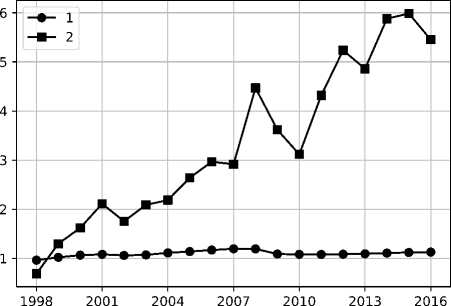
Figure 4. Dynamics of values of region’s basic production indicators for the Murmansk Oblast in 1998–2016 compared with values of 1997:
(b)
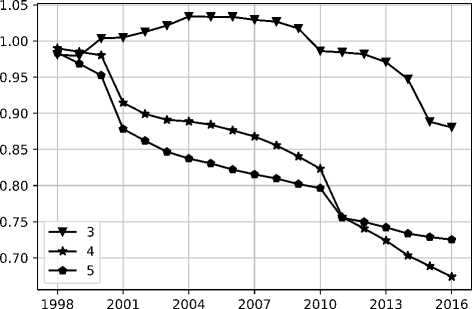
-
(a) 1 – index of physical volume of GRP in comparable prices; 2 – index of physical volume of investments in fixed capital in comparable prices; (b) 3 – average annual number of people employed in the economy; 4 – number of able-bodied population in comparison with 1997; 5 –number of population in comparison with 1997.
Source: own calculations according to data of Federal State Statistics Service [12].
GRP in comparison with 1997
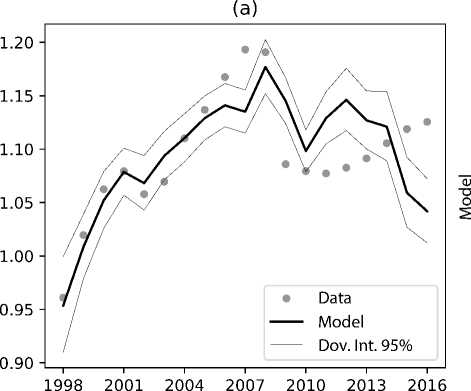
1.20
1.15
1.10
1.05
1.00
0.95
Years
Figure 5. Estimation of parameters of the model (1) for the Murmansk Oblast:
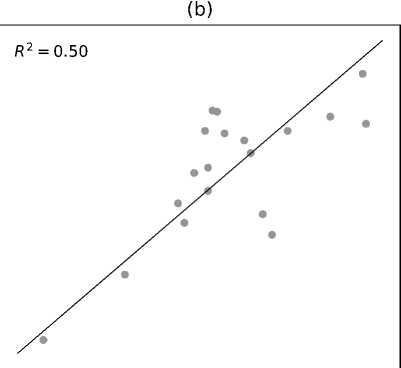
1.00 1.05
1.10 1.15 1.20
Data
-
(a) – dynamics of actual and model values of the GRP physical volume index; (b) – the degree of compliance of the actual model values of the GRP physical volume index (coefficient of determination R 2 = 0.50)
results obtained earlier, which were based on a detailed study of production processes in the Murmansk Oblast within the “all-Northern” and all-Russian situation and took into account fixed assets, the number of employed people in the economy of the Murmansk Oblast, and investments in fixed capital [4, 29].
Thus, for the Murmansk region, there is no clear link between GRP, investments in fixed capital, and the number of people employed in the economy. The same conclusion is true for the number of able-bodied population. This distinguishes the situation in the Murmansk Oblast from the situation across Russia and in most Northern regions [29].
The revealed specifics determined a paradox: the six-time increase of the physical volume of investments in fixed capital of the Murmansk region, observed in 1997–2017, did not provide a significant increase of the physical volume of the region’s GRP (the maximum value was 1.2 times in 2007) ( Fig. 4 ).
We believe that the reasons of the identified specifics must be found in the internal structure of the Murmansk Oblast’s economy. Thus, our preliminary studies show that the lack of growth with multiple investment injections is largely caused by the extractive nature of the region’s old-industrial economy. Let us explain. The largest share in the formation of the Murmansk Oblast’s GRP traditionally belongs to the “Mining” economic activity. The deterioration of the region’s mineral resource base leads to the need for increasing the cost of developing poorer ores, with difficult conditions of occurrence, etc. This requires larger investments, which, in fact, only replace the produced sources of minerals, without creating additional sources of growth. The problem is reinforced by outdated fixed assets. However, this only partially explains the identified effect. In-depth additional research, which goes beyond the subject of the study, presented in this article, is required.
Coming back to the objective of finding the economic effect from the retirement age increase for the economy of the Murmansk Oblast, it is possible to note the following. Given the current structure of the region’s economy, minor fluctuations in the number of able-bodied people, caused by the retirement age increase, will not have a significant impact on the GRP production.
Attitudes of the Murmansk Oblast’s population, caused by the retirement age increase
The empirical basis of the research of the Murmansk Oblast population’s attitudes is the data of the survey, conducted according to the representative all-regional sample of the Murmansk Oblast in 2019 (with quotas based on gender, age, education, and Rosstat territorial zoning) in settlements Kovdor, Monchegorsk, Apatity, Kirovsk, Murmansk, Snezhnogorsk, Polyarny, Kola, Lovozero, Olenegorsk, Polyarnye Zori, Kandalaksha, Umba (number of respondents – 1291 people). The sampling error does not exceed 4%. The data is given in a percentage from the number of respondents. It is important to note that, in this article, we present only a small piece of a large-scale three-year study (2019–2021) funded by RFBR, project no. 19-010-00022. The expedition part of the research is aimed at investigating the specifics of the pension reform’s reflection in minds of the Arctic regions’ population.
Table 4. Distribution of responds of residents of the Murmansk Oblast to the question “How do you feel about the legislative increase of the retirement age?”, in % from the total number of respondents
|
Respond |
Region as a whole (total) |
Men |
Women |
|
Entirely positive |
0.8 |
1.3 |
0.3 |
|
Rather positive |
4.1 |
5.0 |
3.2 |
|
Rather negative |
22.5 |
20.9 |
24.1 |
|
Strongly negative |
64.6 |
67.1 |
62.2 |
|
Hesitant to answer |
8.0 |
5.8 |
10.2 |
|
Source: data of surveys, conducted by the authors. |
|||
Let us first take a look at the overview of attitudes of the Murmansk Oblast’s population toward retirement age increase ( Tab. 4 ). Some received responds were quite predictable in terms of population’s negative attitude toward the reform (87.1% of respondents). There is no country, where people would support the retirement age increase. However, the strong negative attitude, which was shown by 64.6% of respondents, attracts attention. 22.5% of survey participants were inclined to choose “rather negative” answer, 4.1% of respondents are “rather positive”, and 0.8% of people said that they had “entirely positive” attitude toward the reform.
The social acuteness and special soreness of the retirement age increase are indirectly confirmed by the fact that only 8% of respondents found it difficult to answer to question. Such perception could be explained by the fact that Northern benefits include a lower retirement age. A popular behavior strategy of the regions’ population, even regarding younger people, was the movement to climate-friendly areas. Thus, the retirement age change forced the population to significantly adjust their plans. It should be noted that, from the state’s point of view, the relocation of pensioners from the Northern territories is a positive migration trend, which is associated with increased costs of social infrastructure maintenance in the North.
More than 70% of surveyed residents of the Murmansk Oblast believe that the retirement age change does not meet the interests of the population of the North and the Arctic ( Tab. 5 ). Thus, according to 46.3% of respondents, the retirement age increase is definitely not in the interests of the population of the North and the Arctic; 24.7 % of respondents tend to believe that it is rather not in the interests of northerners. A little more than 14% of respondents see the positive effect of the reform for the
Table 5. Distribution of responds of residents of the Murmansk Oblast to the question “Do you agree that the retirement age change meets the interests of the population of the North and the Arctic?”, in % from the total number of respondents
|
Respond |
Region as a whole (total) |
Men |
Women |
|
Definitely yes |
6.2 |
7.9 |
4.6 |
|
Rather yes than no |
7.9 |
8.2 |
7.6 |
|
Rather no than yes |
24.7 |
23.7 |
25.6 |
|
Definitely not |
46.3 |
45.8 |
46.8 |
|
Hesitant to answer |
14.9 |
14.4 |
15.4 |
|
Source: data of surveys, conducted by the authors. |
|||
Table 6. Distribution of responds of residents of the Murmansk Oblast to the question “Did you change your plans, concerning further residence in the Murmansk Oblast, because of the retirement age increase?”, in % from the total number of respondents
|
Respond |
Region as a whole (total) |
Men |
Women |
|
No, they have not changed, I will live and work here |
51.5 |
53.0 |
50.1 |
|
Rather changed, I think about moving to a more comfortable place |
25.6 |
22.5 |
28.5 |
|
Definitely changed, I have already found another place for life and work |
7.5 |
8.5 |
6.5 |
|
Hesitant to answer |
15.4 |
15.9 |
14.9 |
|
Source: data of surveys, conducted by the authors. |
|||
Table 7. Distribution of responds of residents of the Murmansk Oblast to the question “Did you change your plans, concerning further residence in the Murmansk Oblast, because of the retirement age increase?”, taking into account age and gender, in % from the total number of respondents
|
Respond |
Men |
Women |
||||||
|
18–29 |
30–49 |
50–64 |
65+ |
18–29 |
30–49 |
50–64 |
65+ |
|
|
No, they have not changed, I will live and work here |
46.6 |
50.7 |
54.9 |
71.0 |
41.8 |
40.0 |
58.0 |
67.0 |
|
Rather changed, I think about moving to a more comfortable place |
21.2 |
27.8 |
18.8 |
9.7 |
30.6 |
40.8 |
20.2 |
12.5 |
|
Definitely changed, I have already found another place for life and work |
15.3 |
9.5 |
4.9 |
0.0 |
11.2 |
6.5 |
5.2 |
4.5 |
|
Hesitant to answer |
16.9 |
12.0 |
21.5 |
19.4 |
16.3 |
12.7 |
16.6 |
16.1 |
Source: data of surveys, conducted by the authors.
population of the North and the Arctic (out of this number, only 6.2% answered “definitely yes”). Complex and ambiguous influence of the reform on the interests of the population of the North and the Arctic made 14.9% of respondents hesitant to answer.
Out attention is also drawn to changes of migration attitudes among residents of the Murmansk Oblast. These shifts are associated with the retirement age increase by people ( Tab. 6 ). For example, more than 33% of respondents responded positively to the question about changing their residence plans in the Murmansk Oblast due to the retirement age increase.7.5% of them said that their plans “have definitely changed, and they have already found another place of residence and work”.
The most disturbing fact is that members of some groups, such as young people (18–29 years old) and middle-aged people (30–39
years old), have already changed their plans concerning further living in the Murmansk region and think about moving to more climatefriendly places ( Tab. 7 ).
Among young people, 13.3% of respondents changed their plans and found another place of residence and work (15.3% of them are men, 11.2% are women); among the middle-aged people, 8% of the respondents did the same (9.5% of them are men, 6.5% are women). Among young people, 25.9% (21.2% of them are men, 30.6% are women) “started to think” about moving and “rather changed” their plans for further living in the Murmansk Oblast; among middle-aged people, 34.3% of respondents (27.8% of them are men, 40.8% are women) said the same. Such a significant orientation of the population toward migration to other regions creates significant risks for the stability of the economy of the Murmansk Oblast in the near future.
Conclusions
The hypothesis of the study that the retirement age increase is the factor that can change the state of labor resources, the population’s behavior, and significantly alter processes of the economic development of the Arctic region – the Murmansk Oblast – is confirmed.
So, the constructed long-term forecast for the number of able-bodied population in the Murmansk Oblast shows that the retirement age change will suspend the steady trend of the ablebodied population decline in the region. However, we need to emphasize that the decrease of the number of able-bodied population in the Murmansk region will continue. In other words, the retirement age increase will not break the downward trend of the able-bodied population number. This is a qualitative difference from the situation across Russia. Thus, our three-variant forecast for the number of able-bodied population in Russia indicates that the retirement age increase has qualitatively changed the steady trend of the able-bodied population decline: it will increase according to two versions of the forecast. Only the least favorable forecast shows a downward trend, similar to the situation in the Murmansk Oblast.
The study of the GRP production in the Murmansk Oblast revealed that, given the current structure of the region’s economy, a slight decrease of the rate of the able-bodied population reduction, caused by the retirement age increase, will not have a significant impact on the GRP production.
Surveys of residents of the Murmansk Oblast indicated an extremely painful perception of the retirement age change. As it was mentioned earlier, 64.6% of the population expressed strongly negative opinion about the reform, and 22.5% of respondents are “rather negative” about it. Also, there is a strong opinion in the society that the retirement age change does not meet the interests of the population of the North and the Arctic. The vast majority of the region’s residents, who participated in the survey, believe that the increase of able-bodied population (due to the retirement age change) will have a negative impact on the economic situation. It corresponds with the results of the study on the GRP production in the region.
Thus, it is possible to transform the positive effect of slowing down the rate of the able-bodied population decline in the Murmansk Oblast into a noticeable economic result only after the change of the structure of the GRP production. However, there is a negative effect of the retirement age increase – a change of migration attitudes among the most economically active and significant groups of the region’s population (in relation to regional production) – young people (18–29 years) and middle age people (30–49 years). Thus, a significant number of members of these age groups have definitely decided not to live in the Murmansk Oblast, and they link their decision to the increased retirement age.
There is a reason to believe that the positive effect – a shift in the number of able-bodied population of the Murmansk region, caused by the retirement age increase – will be offset by a negative effect – the increase of the rate of migration losses in the region. Comprehensive composite effects of the population decline imply a complex of direct and indirect losses for the regional economy, the calculation of which is another problem of the study.
Список литературы The impact of the retirement age increase on the economy and attitudes of the population of the Murmansk oblast
- Harper S. Economic and social implications of aging societies. Science, 2014, vol. 346 (6209), pp. 587–591.
- Vogel E., Ludwig A., Börsch-Supan A. Aging and pension reform: extending the retirement age and human capital formation. Journal of Pension Economics & Finance, 2017, vol. 16 (1), pp. 81–107.
- Tyrowicz J., Makarski K., Bielecki M. Reforming retirement age in DB and DC pension systems in an aging OLG economy with heterogeneous agents. IZA Journal of Labor Policy, 2016, vol. 5 (1), p. 8.
- Skufina T., Baranov S., Samarina V., Korchak E. Increasing GDP production in the Russian Federation and raising the retirement age: is there a connection? AD ALTA: Journal of interdisciplinary research, 2019, vol. 9 (1), Special Issue VI, pp. 69–72.
- Bloom D.E. et al. Macroeconomic implications of population ageing and selected policy responses. The Lancet, 2015, vol. 385 (9968), pp. 649–657.
- Catalano M., Pezzolla E. The effects of education and aging in an OLG model: long-run growth in France, Germany and Italy. Empirica, 2016, vol. 43 (4), pp. 757–800.
- Trofimova N. A. Use of select mortality tables for forecasting the number of recipients of different types of Pensions. Studies on Russian Economic Development, 2010, vol. 21 (2), pp. 197–203.
- Holzmann R. An optimistic perspective on population ageing and old-age financial protection. Malaysian Journal of Economic Studies, 2017, vol. 50 (2), pp. 107–137.
- Holzmann R. Global pension systems and their reform: worldwide drivers, trends and challenges. International Social Security Review, 2013, vol. 66 (2), pp. 1–29.
- Peng X., Mai Y. Population Ageing, Retirement Age Extension and Economic Growth in China: A Dynamic General Equilibrium Analysis. Centre of Policy Studies and the Impact Project, 2013. 33 p.
- Chistova E.V. Possibilities for increasing the retirement age in Russia in response to population ageing. Montenegrin Journal of Economics, 2016, vol. 12 (3), рp. 127–138.
- Baranov S.V., Skuf’ina T.P. Impact of retirement age increase on the production of gross domestic product in Russia. Innovatsii=Innovations, 2018, no. 9, pp. 38–44. (In Russian).
- Sinyavskaya O.V. The Russian pension system in the context of demographic challenges and restrictions. Ekonomicheskii zhurnal VShE=The HSE Economic Journal, 2017, no.4 (21), pp. 562–591. (In Russian).
- Skuf’ina T.P., Baranov S.V. The Phenomenon of Unevenness of Socio-Economic Development of Cities and Districts in the Murmansk Oblast: Specifics, Trends, Forecast, Regulation. Ekonomicheskie i sotsial’nye peremeny: Fakty, tendentsii, prognoz=Economic and Social Changes: Facts, Trends, Forecast, 2017, vol. 10, no. 5, pp. 66–82. DOI: 10.15838/esc.2017.5.53.5. (In Russian).
- Bielecki M. et al. Decreasing fertility vs increasing longevity: Raising the retirement age in the context of ageing processes. Economic Modelling, 2016, vol. 52, pp. 125–143.
- Wang H., Koo B., O’Hare C. Retirement planning in the light of changing demographics. Economic Modelling, 2016, vol. 52, pp. 749–763.
- Puur A., Leppik L., Klesment M. Changes in pension take-up and retirement in the context of increasing the pension age: the case of Estonia in the 2000s. Post-Communist Economies, 2015, vol. 27 (4), pp. 497–516.
- Barsukov V.N. From the Demographic Dividend to Population Ageing: World Trends in the System-Wide Transition. Ekonomicheskie i sotsial’nye peremeny: Fakty, tendentsii, prognoz=Economic and Social Changes: Facts, Trends, Forecast, 2019, vol. 12, no. 4, pp. 167–182. DOI: 10.15838/esc.2019.4.64.11. (In Russian).
- Kudrin A., Gurvich E. Population ageing and the threat of a budget crisis. Voprosy Ekonomiki=Economic Issues, 2012, no. 3, pp. 52–79. (In Russian).
- Ramonov A. B. Healthy life expectancy as an integral assessment of the health of Russians. Ekonomicheskii zhurnal VShE=The HSE Economic Journal, 2011, vol. 15, no. 4, pp. 497–518. (In Russian).
- Toropushina E.E. Assessment of the level of the social infrastructure development in the North and the Arctic regions. EKO=ECO Journal, 2016, no. 6 (504), pp. 99–108. (In Russian).
- Suopajärvi L., Poelzer G.A., Ejdemo T., Klyuchnikova E., Korchak E. Social sustainability in northern mining communities: A study of the European North and Northwest Russia. Resources Policy, 2016, vol. 47, pp. 61–68.
- Shabunova A.A. Demographic policy: regional dimension. Ekonomika regiona=Regional Economy, 2016, no. 8, p. 59. (In Russian).
- Minakir P. A., Krasnopolskiy B. Kh. Economic mechanisms of introducing new technologies for rational use of Arctic resources. Regionalistica=Regionalistics, 2018, vol. 5, no. 5, pp. 12–24. (In Russian).
- Il’in V.A., Povarova A.I. Consolidated taxation and its implications for regional budgets. Ekonomika regiona=Regional Economy, 2019, vol. 15, no. 1, pp. 70–83. (In Russian).
- Okrepilov V.V., Gagulina N.L. Assessing the quality of institutional transformations in the region’s economy. Ekonomika i upravlenie=Economics and Management, 2018, no. 12 (158), pp. 6–12. (In Russian).
- Uskova T.V. Problems of public administration efficiency. Ekonomika Severo-Zapada: problemy i perspektivy razvitiya=Economy of the North-West: Issues and Prospects of Development, 2016, no. 1 (50), pp. 11–23. (In Russian).
- Samarina V.P. Indicators of the reaction of the Central federal district regions to changes of external conditions. Regional’naya ekonomika: teoriya i praktika=Regional Economics: Theory and Practice, 2012, no. 14, pp. 2–10. (In Russian).
- Baranov S., Skufina T., Samarina V. Regional environment for gross domestic product formation (the case of Russia Northern Regions). Advanced Science Letters, 2018, vol. 24 (9), pp. 6335–6338. DOI: https://doi.org/10.1166/asl.2018.13047
- Kroese D.P., Chan. J.C.C. Statistical Modeling and Computation. Springer, 2014. 400 p. DOI: 10.1007/978-1-4614-8775-3
- Ioan C.A., Ioan G. A generalization of a class of production functions. Applied Economics Letters, 2011, vol. 18, pp. 1777–1784.
- Blaug M. Economic Theory in Retrospect. 5th edition. Cambridge: Cambridge University Press, 1997. Pp. 544–546.

